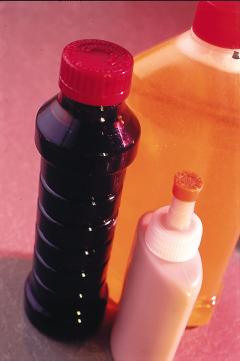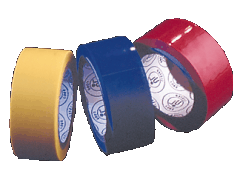Perpetual Plastics
|
Recycling
all plastics
offers many
environmental
and economic
alternatives
By James Hellegaard
photography by Gene Bednarek
|
Of the 75 billion pounds of plastic produced each year in the United States, only 5 percent is recycled, mostly from soft drink and milk bottles. The rest is dumped into landfills, where it will sit for eons, long after all the organic waste around it has decayed.
The problem with plastics is they don't play well together. Until recently, each of the seven major types of plastics had to be recycled separately. If you mixed them together, or co-mingled them, you got weak, brittle material that was virtually useless.
But UF materials science & engineering Professor Charles Beatty has spent
his life studying plastics and the tangled chains of polymer molecules
they're made of, and he could not accept that co-mingled plastics could
not be recycled into useful material.
 |
 |
 |


|
Mixing Oil And Water
``These different plastics are like oil and water,'' Beatty says. ``You mix them up and then they separate.
``Adding detergent causes the oil and water droplets to become very small and stable, forming an emulsion,'' Beatty adds. ``This is the fundamental concept of washing.''
Beatty, director of UF's Polymer Processing and Properties Center, and his colleagues are researching the precise combinations of chemicals, pressure and mixing variables necessary to modify the polymer chains of many plastics to form tough, ductile polymeric alloys.
Much like in the oil-and-water analogy, UF's process creates a compatibilizer that acts like a detergent to emulsify different types of polymers.
Virtually all plastics are made from seven basic resins. Two --- polyethylene terephthalate (PET) used in soft drink bottles and high-density polyethylene (HDPE) used in milk bottles --- are already successfully recycled on their own.
The other five serve as the raw material for Beatty's recycling process. They include polyethylene, used for bleach and detergent bottles; polypropylene, used for a variety of consumer products such as milk and soda bottle caps, car battery cases and snack food containers; polystyrene, like Styrofoam, used in fast-food containers, egg cartons and disposable plates and cups; and Plexiglas and PVC, or vinyl, for products like floor tile, pipe and house siding.
These materials are ground up to produce quarter-inch flakes and washed to remove metal, rocks, wood and other contaminants. The flakes are fed into a $500,000 reactive extruder in Beatty's laboratory, where they are melted down into microscopic particles.
The key to the whole process, Beatty says, is a precise ``shearing'' of the polymer molecules in the extruder, whose many blades mix the combination of plastics like cake batter, tearing apart the globs of polymers that makes each of the original plastics unique, known as domains, and emulsifying them into an alloy.
``There are a lot of variables,'' Beatty says. ``The extruder screw design and rate of rotation determine the shear rate, and then we have to determine where to inject the reactive chemicals, for how long, under what temperature and pressure.''
The result is a polymer alloy. Just as brass is an alloy of copper and zinc, a polymer alloy is a mixture of different plastic resins that have become ``compatibilized.''
``The polymer chains that bridge the different domains have to be long enough to become entangled with other chains,'' Beatty says. ``These chains provide the stress transfer that makes the alloy strong and tough.''
Beatty gives a graphic demonstration of his team's efforts.
He takes an early, ``uncompatibilized'' sample of mixed, recycled plastic and slaps it hard against a desk. Pieces fly in all directions. Then he takes a piece of the same mixture of post-consumer plastics that has been ``compatibilized'' and performs the same test. It survives intact.
The Florida Department of Transportation is already taking advantage of Beatty's earlier research. More than 10,000 recycled plastic posts are supporting fences and signs around the state. The posts are being tested for their durability in five different soil and environmental conditions. Beatty estimates these posts will last 100 years, saving the state $2 billion in replacement costs over their lifetime.
But the posts are crude predecessors to the kinds of higher-value recycled plastics Beatty now envisions --- everything from pre-fabricated plastic houses to car parts and mailboxes.
Creating A Market
Beatty gives much of the credit for spurring the plastics recycling effort in Florida and nationally to state Sen. George Kirkpatrick of Gainesville. Kirkpatrick authored Florida's 1988 Solid Waste Management Law, which provides incentives and benefits for recycling and has been copied with modification by more than 40 states. Several Eastern European and South American countries also are considering adopting similar laws.
With more and more products being made out of plastics, and less and less space for them in landfills, both the public and private sectors are eager to support plastics recycling efforts.
When Beatty proposed a feasibility study in 1991 of ways to make incompatible plastics tolerate each other well enough to produce strong, ductile materials, government and industry supported it enthusiastically. The Council of Solid Waste Solutions (now called the American Plastics Council) sponsored the project with matching funds from the State of Florida.
Beatty leveraged the state's $60,000 in funding for that early study into a $5.8 million Advanced Technology Project grant funded with $2 million from the National Institute of Standards and Technology (NIST), $1 million from Eastman Chemical, $1 million from InterRecycling Corp. and $1 million from Eagle Plastics Systems. Michigan Molecular Institute and Eastman Kodak also participated in the project.
Beatty says the difference between this process and earlier plastics recycling efforts is that it ``makes sense economically.''
``In north-central Florida, it would cost about four cents a pound to put these plastics in a landfill,'' he says. ``The chemical materials cost for modifying post-consumer plastics packaging material is less than one cent a pound. And now they can be made into something useful, instead of taking up space in a landfill.''
In addition, compatibilized post-consumer plastic packaging material costs only 20 cents a pound --- less than half the cost of virgin high-density polyethylene (milk bottle plastic).
``What makes it important is not the fact that you can do it ---
that's nice from a scientific point of view --- but the fact that we
can do it inexpensively, so that it's economically viable from a business
point of view,'' Beatty says.
|
Practical Test
The first test of Beatty's compatibilized, post-consumer plastics has been in the construction of low-cost, modular homes. Four-inch-thick walls are fabricated by sandwiching fiberglass insulation between two thin walls of compatibilized plastic screwed to galvanized steel beams. Several of the buildings have been constructed on the UF campus for use as an office and conference room, a recycled plastics lab research building and a building housing aquaculture research.
As part of the NIST grant, Eagle Plastics Systems, a company based in Pompano Beach, Fla., is commercializing Beatty's technology by constructing temporary modular buildings from recycled plastics.
During the NIST project, the researchers installed recycled plastic sheets on Eagle Plastics Systems' temporary modular buildings in 17 countries, including Brazil, several Caribbean nations, Canada, the United States and Japan.
Based on this research, Eagle Plastics Systems estimated it could generate $100 million in contracts within five years, Beatty says. As it turns out, the company reached that milestone within its first year and now has agreed to fund Beatty's research in the amount of $1 million a year for 10 years.
In addition, Eagle plans to construct a prototype plant on or near the UF campus.
``The Polymer Processing and Properties Center will provide research and development services for this company,'' Beatty says. ``Once we get this prototype plant up and running, then they will duplicate it on a bigger scale elsewhere. Then, we'll use the prototype plant in Gainesville to do research studies on the manufacturing process.''
Eagle Plastics Systems has a building assembly plant in Brazil, where 40,000 homes already are on order, Beatty says. The first buildings were delivered in December 1996.
The company also has constructed two assembly plants in the Appalachia area of Kentucky and began constructing houses in the region last November. CSX Railroad, which hauls much of the coal out of the region, has agreed to bring bales of recycled plastics back on its cars.
``They build these modular buildings for about $6 a square foot,'' Beatty says. ``Compare that to the cost of any type of conventional housing, which is about $50 a square foot.''
The buildings are being used as orphanages in Guatemala and classrooms in Costa Rica. Eagle Plastics has received approval from the Federal Emergency Management Agency to use the buildings in disaster-relief situations.
The pre-fabricated panels fit together in a patented track assembly, so a building can be constructed in a matter of hours.
When an earthquake struck the Japanese city of Kobe, the U.S. Air Force flew the modular panels for two buildings from South Florida to Japan.
``From the time of the earthquake until two buildings were up and ready
was less than 24 hours,'' Beatty says.

He adds that the technology holds particular promise for Third World countries, where there are few incentives to properly dispose of plastic litter.
``Many Third World countries have little or no mechanisms for handling all this plastic packaging, and so it's all over the streets and along the roads,'' he says. ``They usually don't have recycling bins or the technology for collecting it or doing anything with it.''
Beatty says that creating an economically viable plastics recycling industry in these countries could reduce litter and pollution problems caused by burning, and provide affordable housing and much-needed jobs.
The work has come to the attention of Klaus Nobel of the Nobel Prize family, who annually awards an environmental Earth prize. Nobel is now working with Eagle Plastics, South African President Nelson Mandela and the World Bank to find funding to build compatibilization and assembly plants in Cape Town and Johannesburg. While that project is still under negotiation, Beatty and his students are encouraged by the prospect that this research could prove so beneficial.
``It's a nice feeling,'' Beatty said, ``that you can do research that can improve the quality of life for so many people in the world.''
Charles L. Beatty
Professor, Department of Materials Science & Engineering,
(352) 392-1574
